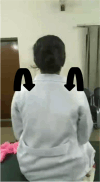Comparing the effects of neck stabilization exercises versus dynamic exercises among patients having nonspecific neck pain with forward head posture: a randomized clinical trial
- PMID: 39232708
- PMCID: PMC11373259
- DOI: 10.1186/s12891-024-07749-8
Comparing the effects of neck stabilization exercises versus dynamic exercises among patients having nonspecific neck pain with forward head posture: a randomized clinical trial
Abstract
Background: Nonspecific neck pain (NSNP) is a well-established global burden affecting. It is also a common problem in Pakistan. The burden of neck pain is also increasing day by day due to poor work ergonomics, and increased use of computers and mobiles after the pandemic. An individual's poor posture is often associated with forward head posture (FHP). Limited evidence is available about the effects of neck stabilization (NSE) and dynamic exercises (NDE) for nonspecific neck pain particularly in patients with FHP. This aimed to compare the effects of NSE versus NDE among patients having NSNP with FHP in reducing pain, disability, forward head posture and improving neck range of motion.
Methods: It is a single-blinded randomized clinical trial with 60 patients aged 18-40 years, with moderate intensity NSNP for > 3 weeks and < 6 months along with FHP with a moderate disability on neck disability index (NDI) randomly assigned to the treatment groups. Group 1 was doing NSE and group 2 was doing NDE. Transcutaneous Electical Nerve Stimulation, cold packs, and stretching exercises were given to both groups. A total of 9 sessions (3 sessions/ week) were given to participants. NDI questionnaire, Visual analogue scale (VAS), goniometry, and plumb line measurement tool were used as baseline and assessment at the end of 3rd week. The data was analyzed on SPSS version 21. Descriptive analysis was performed. Independent t-test was used for between group comparison and paired t-test used for within group comparison. A p-value less than 0.05 was considered statistically significant.
Results: After treatment within-group analysis of both NSE and NDE showed significant (p < 0.001) improvement in pain on VAS, all ROMs of the neck including flexion, extension, left and right lateral flexion and left rotation, plumb line and NDI score with very large effect size. However, between-group analysis showed non-significant differences (p > 0.05) for post-treatment mean VAS, neck ROM, NDI and plumb line measurement.
Conclusion: Between NSE and NDE, no one is more beneficial than another. Both are equally effective in alleviating pain, increasing ROM, decreasing functional disability, and improving forward head posture in patients with NSNP.
Trial registration: Registered trial at ClinicalTrials.gov Identifier: NCT05298631, 28/03/2022, prospectively registered.
Keywords: Isometric exercises; Isotonic exercises; Nonspecific neck pain.
© 2024. The Author(s).
Conflict of interest statement
The authors declare no competing interests.
Figures
Similar articles
-
Upper thoracic spine mobilization and mobility exercise versus upper cervical spine mobilization and stabilization exercise in individuals with forward head posture: a randomized clinical trial.BMC Musculoskelet Disord. 2017 Dec 12;18(1):525. doi: 10.1186/s12891-017-1889-2. BMC Musculoskelet Disord. 2017. PMID: 29233164 Free PMC article. Clinical Trial.
-
Addition of a new three-dimensional adjustable cervical thoracic orthosis to a multi-modal program in the treatment of nonspecific neck pain: study protocol for a randomised pilot trial.Trials. 2019 Apr 29;20(1):248. doi: 10.1186/s13063-019-3337-0. Trials. 2019. PMID: 31036033 Free PMC article.
-
A Comparison of the Effects of Stabilization Exercises Plus Manual Therapy to Those of Stabilization Exercises Alone in Patients With Nonspecific Mechanical Neck Pain: A Randomized Clinical Trial.J Orthop Sports Phys Ther. 2016 Feb;46(2):44-55. doi: 10.2519/jospt.2016.5979. Epub 2016 Jan 11. J Orthop Sports Phys Ther. 2016. PMID: 26755405 Clinical Trial.
-
The comparison of two corrective exercise approaches for hyperkyphosis and forward head posture: A quasi-experimental study.J Back Musculoskelet Rehabil. 2021;34(4):677-687. doi: 10.3233/BMR-200160. J Back Musculoskelet Rehabil. 2021. PMID: 33896809 Clinical Trial.
-
Impact of forward head posture correction on craniovertebral angle, neck disability, and spinal electromyography: A randomized controlled trial.J Back Musculoskelet Rehabil. 2025 Jan;38(1):83-92. doi: 10.1177/10538127241296342. Epub 2024 Dec 19. J Back Musculoskelet Rehabil. 2025. PMID: 39970467 Review.
Cited by
-
The Effectiveness of an Exercise Program Based on Motor Learning Principles for the Correction of the Forward Head Posture: A Randomized Controlled Trial.Brain Sci. 2025 Aug 15;15(8):873. doi: 10.3390/brainsci15080873. Brain Sci. 2025. PMID: 40867204 Free PMC article.
References
-
- Gautam R, Dhamija JK, Puri A, Trivedi P, Sathiyavani D, Nambi G. Comparison of Maitland and Mulligan mobilization in improving neck pain, ROM and disability. Int J Physiother Res. 2014;2(3):561–6.
-
- Ijaz A, Khan I, Ahmed A, Sadiq S. Frequency of neck pain among dentists. Pakistan Orthodontic J. 2016;8(2):89–93.
-
- Kaka B, Ogwumike OO. Effect of neck stabilization and dynamic exercises on pain, disability and fear avoidance beliefs in patients with non-specific neck pain. Physiotherapy. 2015;101:e704. 10.1016/j.physio.2015.03.3555 - DOI
Publication types
MeSH terms
Associated data
LinkOut - more resources
Full Text Sources
Medical










